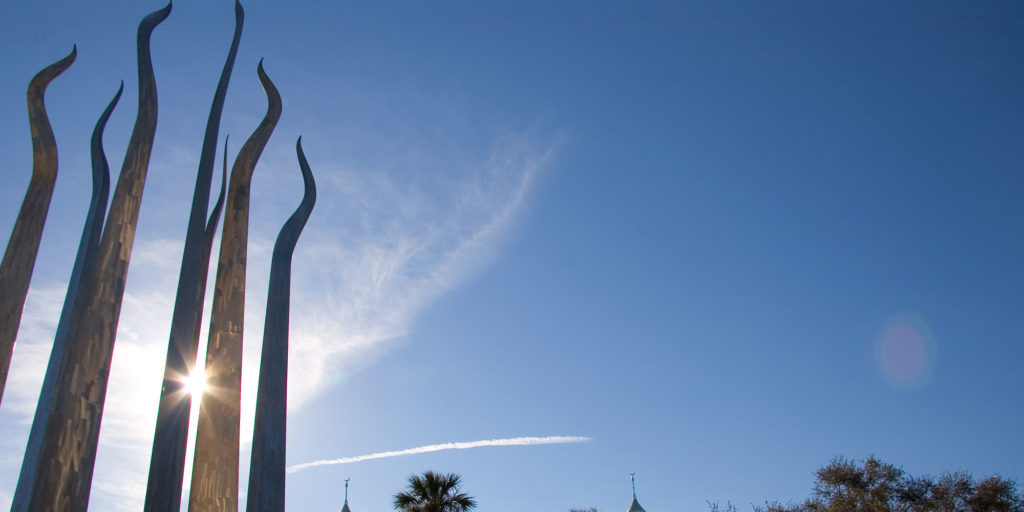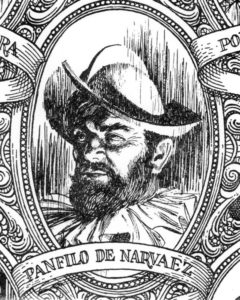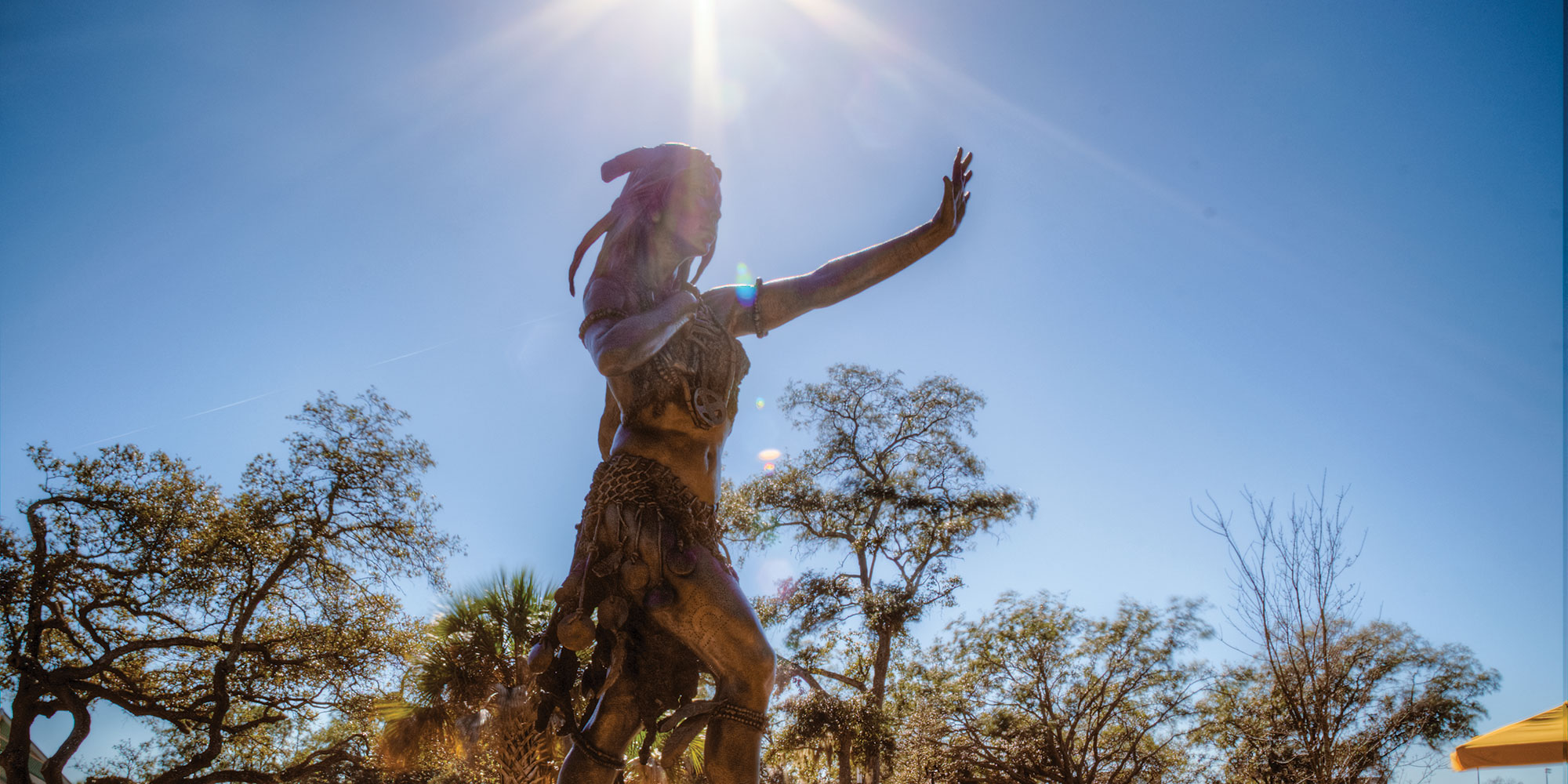
Columbus’ discovery of the New World in 1492 was an opportunity for battle-tested soldiers of the Reconquista to gain fame, glory and wealth expanding the Spanish empire.
Conquering modern-day Cuba and Puerto Rico, the Spanish were intrigued by stories of a rich land to the north; little did they know they would encounter a civilization nearly as intractable and violent as their own. The story of the first people of Tampa Bay is eternally intertwined with that of the first European explorers.
From roughly 900 to 1700 A.D. the Manasota civilization expanded and diversified around the Bay area, decentralizing to separate chiefdoms based around a large earthen mound used for ceremonial purposes in the heart of the village, with significant territorial claims between them.
Estimates from The Florida Anthropologist place at least 15 distinct, smaller “temple mounds” around Tampa Bay that marked the presence of tribes. Among the most influential at the beginning of European exploration was the Tocobaga tribe, which most likely inhabited the current city of Safety Harbor. Also identified were the Mocoso, who lived near the Alafia River; the Pohoy of northern Hillsborough Bay, near modern Tampa; and the Uzita, who occupied the southwestern shores near the Little Manatee River. Collectively, these became known as the Safety Harbor Culture.
Tampa Bay’s indigenous population peaked when the conquistadors first arrived. The age of exploration signaled the natives’ immediate decline.
Exploration of Florida began with a soldier of fortune who had fought the Reconquista and later claimed Hispaniola for Spain over the native Tainos – Juan Ponce de Leon, who was among the most respected explorers of the New World.
In 1513, de Leon sailed with three ships north from Hispaniola up Florida’s east coast, landing briefly to claim the new territory La Florida for the Spanish crown. Then sailing south, the crew rounded the Florida Keys and made landfall in present-day Charlotte Harbor, where their first encounter with Calusa natives did not go well. Refusing to trade, armed warriors surrounded the Spanish galleys in ocean canoes until they left. It wasn’t until 1521 that de Leon returned, but, fatally shot in the leg with a poisoned arrow, he died in Havana months later.
Word spread of de Leon’s “great harbor” that the Calusa called “Tanpa,” believed to mean “sticks of fire” in reference to the area’s abundant lightning strikes. Confusing Tampa Bay with Charlotte Harbor, later conquistadors would mistakenly attribute the name to their landing sites inside the Bay resulting in the city’s eventual name – Tampa.
***

Panfilo de Narvaez, a soldier who rose through the ranks on a tide of violent conquest, heard talk in the years following de Leon’s death that there was an open claim to La Florida. Assembling an army 600 strong, Narvaez retraced de Leon’s route in 1528, losing two ships to a hurricane before even making landfall, per 1904’s “A History of Florida.”
They landed near temple mounds at present-day Jungle Prada de Narvaez Park in St. Petersburg. Narvaez declared the territory for Spain, made himself governor and gave the Tocobaga two choices: swear allegiance to Spain and convert to Catholicism, or death.
Narvaez sailed to the Little Manatee River and encountered the Uzita, a fierce tribe who collected scraps of gold from shipwrecks washed ashore. When his demands for treasure went unheeded, Narvaez ordered his men to torture the natives, feeding some to the army’s dogs and cutting off the nose of Chief Hirrigua.
The crew continued north until, nearly wiped out, Narvaez ordered the construction of rafts to escape to the gulf. A storm absorbed the explorers as they neared the coast, pulling Narvaez out to sea, never to be seen again.
***
Meanwhile, a scout ship returned to the landing site after Narvaez left. Unable to find Narvaez’s crew, the new explorers returned months later with reinforcements near the Uzita village ravaged by Narvaez. According to legend, the vengeful Chief Hirrigua used the men for target practice. The last alive, a young sailor named Juan Ortiz, was ordered to be roasted on an open fire.
At the last moment, Ortiz was pitied by Hirrigua’s daughter, Ulele, who begged her father for mercy. Ortiz was spared and enslaved, but Hirrigua’s rage could not be placated. Fearing for Ortiz, it is believed Ulele arranged for him to escape to the protection of her betrothed, the Chief Mocoso, near the Alafia River. The plan worked – Ortiz was saved – but, enraged, Hirrigua forbid Ulele from marrying Mocoso. Ortiz would spend twelve years living with the Mocoso, learning their language and territory as well as any native.
Ortiz lived with the natives until the arrival of Hernando de Soto. De Soto’s exploits over Incan Peru made him fabulously wealthy before he was 35. A disciplined commander and violent toward natives, de Soto was admitted to the Order of Santiago by King Charles, earning the right to conquer Florida. The de Soto flotilla arrived in southeastern Tampa Bay in 1539 with an estimated nine ships, 620 men and 220 horses, funded entirely by de Soto’s own fortune.
De Soto made landfall at present-day Piney Point, near Terra Ceia in Manatee County, behind several scouts who captured natives as guides. The scouts united de Soto with castaway Juan Ortiz, by now covered with indigenous tattoos and fluent in several local languages. Brought in as a translator and guide, Ortiz told de Soto there was no gold in the land, but de Soto still led an expedition north along the east coast of Tampa Bay into Zephyrhills.
***
De Soto was consumed with regaining his riches in Florida and enslaved, mutilated or executed anyone who stood in his way. In addition to the inhospitable landscape, the Spanish were under constant attack by natives; some who acted as guides would lead them directly into ambushes. Others, like the Apalachee, burned their village and crops before the explorers arrived. De Soto clung to survival as far west as Arkansas, his resources and men heavily depleted. He died on the shores of the Mississippi River in 1542, just as Juan Ortiz had a few months prior.
Though Tampa Bay wouldn’t see further exploration until the Civil War era, the Spanish explorers had permanent effects on the entire indigenous population. Chiefdoms not erased by disease and persecution became openly hostile towards those who aided the intruders. Through truce and conquest, those that did not homogenize and band together slipped into the forests, never to be seen again.



